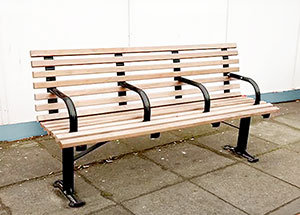
So-called hostile architecture, which discourages resting and sleeping in public spaces, has been deemed inappropriate by the Somerville City Council.
By Alex Reidy
The April 8 City Council meeting saw many resolutions passed, including that one appointing the Director of Mobility and Commissioner of Public Works work with the State Delegation to remove hostile architecture from the Davis Square MBTA station, as well as to ensure that no hostile architecture continues to be installed around the city.
Hostile architecture is specifically designed to target vulnerable populations such as the homeless to “push them out of an area” as Robert Rosenberger an associate professor of Philosophy at Georgia Institute of Technology writes.
Hostile architecture features in the MBTA stop at Davis Square consist of armrests in benches, which at first were designed to be in compliance with the Americans with Disabilities Act, but have gradually made them harder for people to use in the way that homeless people have been using them for years. This includes resting, sleeping, and reclining in comfortable ways.
It is, in effect, a way to push homeless people away from public spaces and out of the public eye. If the problem cannot be seen then the problem is not there, as some might see it.
Another important agenda item addressed was the unanimous approval of the regulation of chemical crowd control agents and kinetic impact projectiles. As stated in the briefing, “The use of pepper spray by the SPD or any other law enforcement officer shall not be permitted unless an emergency exists that requires the immediate use of Pepper Spray to prevent serious bodily injury or death, (A) an Officer personally witnesses on going and illegal acts of violence, property destruction, imminent threats of violence, or imminent threats of property destruction involving a weapon, (B) is unable to arrest or detain an individual using a lower level of force, and (C) provides a clear verbal warning of the imminent deployment of Pepper Spray prior to its use and affords a reasonable opportunity for the individual(s) to cease and/or comply.”
These changes come in the wake of the George Floyd killing that occurred in Minneapolis last year, where alleged excessive force by a police officer used in an arrest ended in the death of the detainee.
This change in policing tactics has been a common discussion in the Somerville government as seen in previous statements by Ward 5 Councilor Niedergang concerning reduction of the number of police officers in the city and how conduct their duties.















‘Director of Mobility and Commissioner of Public Works work with the State Delegation to remove hostile architecture from the Davis Square MBTA station, as well as to ensure that no hostile architecture continues to be installed around the city.’
But will the ‘hostile architecture’ already placed around the city be removed? It isn’t just benches with arm rests. A few years ago Kenney Park in Somerville saw their benches removed and replaced with tiny, flimsy round tables with chairs. Certainly not meant for the comfort of any adult, and also difficult for people with certain disabilities to use.
Why is this called “hostile architecture” rather than “public safety architecture?” It serves a purpose in supporting safety and social stability. As an alternative, may I suggest that the city officials who are against “hostile architecture” instead post a sign above the benches listing their home addresses and inviting those who wish to sleep on the bench into their homes.
The real “hostile architecture” in this town is the hostility being directed at auto users with the pandemic-rate growth of speed bumps, bus and bicycle only lanes, and chicanes.
This is good, glad to see moves towards humanizing architecture in the city. There are smart ways to continue to involve our infrastructure – e.g. we dont need segregated bike lanes everywhere rather we need a few with lots of feeder access. As for speed bumps, I would love to see more, effective ways of slowing folks down on our streets. When residents of my street reached out to our alderman requesting one we were told it was hard to do.